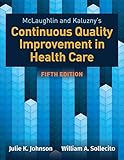McLaughlin and Kaluzny's continuous quality improvement in health care / Julie K. Johnson, PhD, MSPH, William A. Sollecito, DRPH.
Material type: TextPublisher: Burlington, MA : Jones & Bartlett Learning, 2020Edition: Fifth editionDescription: xvii, 354 pages ; 23 cmContent type:
TextPublisher: Burlington, MA : Jones & Bartlett Learning, 2020Edition: Fifth editionDescription: xvii, 354 pages ; 23 cmContent type: - 9781284126594
- 1284126595
- Continuous quality improvement in health care
- 362.10973 JOH
- RA399.A3 C66 2020
- 2019 A-477
- W 84.1
| Item type | Current library | Call number | Status | Date due | Barcode | |
|---|---|---|---|---|---|---|
| Long Loan | TUS: Midlands, Main Library Athlone General Lending | 362.10973 JOH (Browse shelf(Opens below)) | Available | 224811 | ||
| Long Loan | TUS: Midlands, Main Library Athlone Nursing Collection | 362.10973 JOH (Browse shelf(Opens below)) | Available | 224810 | ||
| Long Loan | TUS: Midlands, Main Library Athlone Nursing Collection | 362.10973 JOH (Browse shelf(Opens below)) | Available | 224809 |
Includes bibliographical references and index.
Machine generated contents note: ch. 1 The Global Evolution of Continuous Quality Improvement: From Japanese Manufacturing to Global Health Services -- Definitions -- Rationale and Distinguishing Characteristics -- Elements of CQI -- Evolution of the Quality Movement -- The Big Bang -- The Quality Chasm -- From Industrialization to Personalization -- The Scientific Method of CQI -- Conclusions -- References -- ch. 2 Factors Influencing the Application and Diffusion of CQI in Health Care -- The Current State of CQI in Health Care -- CQI and the Science of Innovation -- The Business Case for CQI -- Factors Associated with Successful CQI Applications -- Culture of Excellence -- Kotter's Change Model -- Conclusions -- References -- ch. 3 Integrating Implementation Science Approaches into Continuous Quality Improvement -- Implementation Science Defined -- Integrating Implementation into QI: The Model for Improvement and Implementation
Note continued: Implementing Well: Using Frameworks for Implementation -- Conclusions -- References -- Appendix 3.1 Definitions of CFIR Constructs -- Appendix 3.2 Implementation Strategies and Definitions -- Appendix 3.3 Categories and Strategies -- Appendix 3.4 List of Behavioral Change Techniques -- ch. 4 Understanding Variation, Tools, and Data Sources for CQI in Healthcare -- Health Care Systems and Processes -- Gaining Knowledge Through Measurement -- Quality Improvement Tools -- Sources of Data for CQI -- Conclusions -- References -- ch. 5 Lean and Six Sigma Management: Building a Foundation for Optimal Patient Care Using Patient Flow Physics -- Lean and Six Sigma Management Defined -- Lean Management System (LMS) -- Conclusions -- References -- ch. 6 Understanding and Improving Team Effectiveness in Quality Improvement -- Teams in Health Care -- High-Performance Teams and Quality Improvement
Note continued: Understanding and Improving the Performance of Quality Improvement Teams -- Resources and Support -- Team Processes -- Conclusions -- References -- ch. 7 The Role of the Patient in Continuous Quality Improvement -- Patient Involvement in Health Care Improvement: A Brief Overview -- Rationale for Patient Involvement in CQI -- Methods for Involving Patients in CQI -- Factors Affecting Patient Involvement -- Measuring Patient Involvement in CQI -- The M-APR Model of Patient Involvement -- Conclusions -- References -- ch. 8 A Social Marketing Approach to Increase Adoption of Continuous Quality Improvement Initiatives -- Hallmarks of Social Marketing -- Social Marketing Applications to CQI in Health Care -- A Scenario for How to Apply Social Marketing to a Health Care CQI Initiative -- Conclusions -- References -- ch. 9 Assessing Risk and Preventing Harm in the Clinical Microsystem -- Risk Management -- Background and Definitions -- Models of Risk Management
Note continued: Engineering a Culture of Safety -- Applying Risk Management Concepts to Improving Quality and Safety Within the Clinical Microsystem -- Role of Risk Management and Patient Disclosure -- Conclusions -- References -- ch. 10 Classification and the Reduction of Medical Errors -- Why Classify Safety Events? -- Skill-, Rule-, and Knowledge-Based Classification -- Conclusions -- References -- ch. 11 Continuous Quality Improvement in U.S. Public Health Organizations: Widespread Adoption and Institutionalization -- Clarifying Key Terms -- History of Actions to Promote CQI in Public Health -- Factors Affecting the Ongoing Adoption and Institutionalization of CQI in Public Health -- Conclusions -- References -- ch. 12 Health Service Accreditation: A Strategy to Promote and Improve Safety and Quality -- An Overview of Accreditation -- Accreditation: A Common Strategy to Improve Health Organizations and Care
Note continued: Accreditation: A Process Promoting Continuous Quality Improvement -- Accreditation Agencies, Standards, and Surveyor Reliability -- Public Health Accreditation in the United States -- Conclusions -- References -- ch. 13 Quality Improvement in Low- and Middle-Income Countries -- Variation in Health Outcomes -- New Challenges and Opportunities for QI -- QI Frameworks and Methods -- Conclusions -- References -- ch. 14 Future Trends and Challenges for Continuous Quality Improvement in Healthcare -- Setting the Stage for CQI -- Conceptual Frameworks for Improving Care -- Road Map for the Future -- Conclusions -- References.
"Through a unique interdisciplinary perspective on quality management in health care, this text covers operations management, organizational behavior, and health services research. With a particular focus on Total Quality Management and Continuous Quality Improvement, the challenges of implementation and institutionalization are addressed using examples from primary care clinics, hospital laboratories, public health departments, and academic health centers"-- Provided by publisher.
